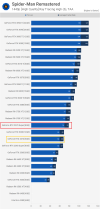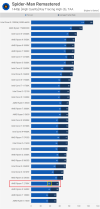Which brings me to my penultimate point.
Architecture - I see that you are saying this is nothing to do with the PS5 architecture or console to PC, but it really is. As the point is that Console have a Unified Ram architecture (hUMA) and PC does not, well dGPU's mostly do not. As such if they did then changes here would not need to made to source to compensate (and whatever work the driver will be doing, although DX12 does but memory allocation almost entirely on the Developer now compared to DX11). The fact is the PC has to 'Waste' Ram, Bandwidth, CPU and GPU cycles etc etc where the Console does not. And the results present this, this is not to say things cannot be changed, improved etc but they cannot be solved only worked around or powered past (within reason). Hence why more VRAM helps, faster PCIe helps, faster CPU helps, faster SYSram helps etc etc.
I think as a forum post, this is fairly acceptable, but presenting this on IGN for instance is misleading imo.
Mainly when we think of architecture, we think of pillars that hold something up, the shape, the multiple systems working together to create performance. The only challenge with this title has just been this VRAM bottleneck, for a video card that was never marketed to be 4K. And as a reviewer, in particular, your role in evaluating hardware should be to evaluate it based on how well it achieves what it set out to do, and the 3070 was never marketed as a 4K native card. I should be clear here, while the ALU is quite high for what it is, but the VRAM amounts are fairly paltry, and Nvidia has been well criticized for this. And so to ask a card, to do something it shouldn't be capable of and then say this is where PS5 is better architecture is misleading. There's nothing particular about architecture when we are discussing a bottleneck, so if you're going to talk about why a card doesn't perform, there should have been a large segment on hitting VRAM limitations. If you want to see how a card performs without VRAM limitations, you need to setup for that and explain that experiment to the viewers.
I think saying things like the PC has to waste ram, bandwidth, CPU and GPU cycles where consoles do not, is not the full story either. HUMA architectures prioritize CPU bandwidth over GPU, meaning contention and in particular asymmetrical contention of bandwidth. Its a large reason why we're seeing such low AF settings in comparison to PC. Consoles, in particular PS5, has to deal with sharing of power between CPU and GPU, which doesn't happen in the PC space, both CPU and GPU are free to clock as high as the silicon can handle. PCIE bandwidth is effectively higher than SSD on PS5 if you're looking purely at bringing textures in. The only challenge here is that there are so many configurations around memory, that most developers won't target 16-32GB of system memory for PC in terms of using system memory in that way. But really we're talking about a PORT here, in which if they wanted this to run well on PC, they would have had to rewrite a large portion of the streaming system to accommodate for smaller VRAM amounts, but with huge system RAM amounts, and they didn't want to do that. And that's okay, but that's precisely why we need to bring VRAM limitations front and center. If Developers won't code for it, maybe we shouldn't be buying or they should sell video cards with such paltry VRAM.
But, we need to keep in focus that VRAM is Hardware and is part of the GPU. My test(s) are designed to test the GPU at the same settings as the console (or as close as possible) which WILL and SHOULD include the VRAM
Sure, but once again, the VRAM allocation provided to the xx70 series cards are designed for resolutions at 1440p. And games that require more VRAM at certain settings makes this impossible for it despite the other components on the GPU. It doesn't matter how much ALU, or rasterizers, or triangles a GPU can push, when all that hardware is sitting idle waiting for work to arrive. And that's a pretty critical piece in explaining performance here. Talking about when a GPU is sitting idle due to a bottleneck, and saying that a GPU has hit its hardware at these settings are very profoundly different messages.
I can go through the first pages of Neogaf, or other Pro Sony sites, and it's clear the messaging there (from your video) is that the PS5 is outperforming these cards without any real understanding of why. I think as much as you are having a tough time here with certain posters, you need ask yourself, if those people got the messaging right over there. If you're comfortable with that, then so be it. But if you're not, and you feel like people aren't getting the message, then you should consider which messages you are glossing over, and which messages you are driving home in those videos.
I don't know if it's clear, your messaging in your videos is showing how PS5 is punching above it's weight. I think most PC people would disagree with that messaging, if you think that is the wrong messaging we are receiving then I think it makes sense to see what you said that got us thinking that way. I think VRAM limitations is something that needs to be brought forward with messaging, especially to Nvidia and the PC community. That needs to be a full discussion so that people are not mistaking ALU performance for VRAM bottlenecks. You claim you bring it up, but I didn't get that from your video, it's there in passing , but I think it's pretty clear the main message is not that.
I wish you the best of luck, honestly, whether you care or not what we think doesn't matter. But each time you make a video, there is an opportunity to improve or rectify. I don't know if you want to go back and address this, it's up to you. Your videos cause our forums to come to life, for the wrong reasons perhaps, but it comes to life, so I don't mind it. Certainly glad you are here to discuss your points. I don't see another forum that is going to give you good shop talk feedback.


